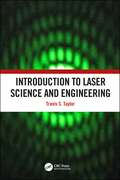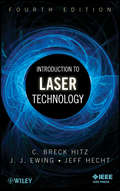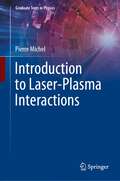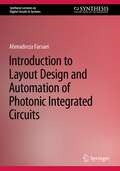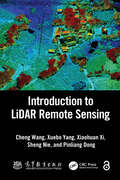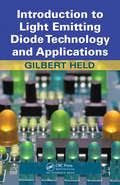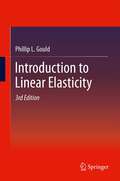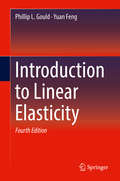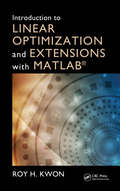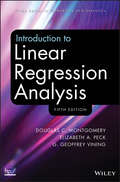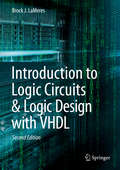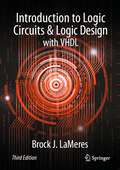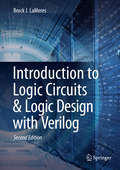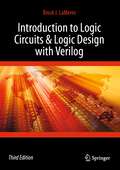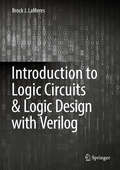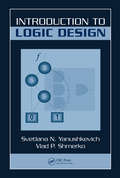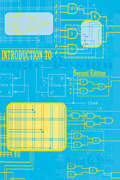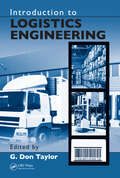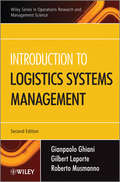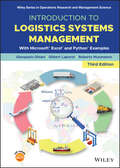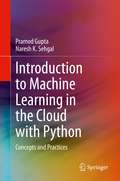- Table View
- List View
Introduction to Laser Science and Engineering
by Travis S. TaylorIntroduction to Laser Science and Engineering provides a modern resource for a first course in lasers for both students and professionals. Starting from simple descriptions, this text builds upon them to give a detailed modern physical understanding of the concepts behind light, optical beams and lasers. The coverage starts with the nature of light and the principles of photon absorption and transmission, leading to the amplified and stimulated emission principals governing lasers. The specifics of lasers and their application, safe use and future prospects are then covered, with a wealth of illustrations to provide readers with a visual sense of optical and laser principles.
Introduction to Laser Technology (Fourth Edition)
by Jeff Hecht C. Breck Hitz J. J. EwingThe only introductory text to explain the underlying physics and engineering applicable to all lasers, Introduction to Laser Technology presents a unique combination of clarity and technical depth. The book features an introductory chapter explaining the characteristics and important applications of commercial lasers worldwide as well as discussions on light and optics, the fundamental elements of lasers, and laser modification. This fourth edition includes a new chapter on fiber lasers, a discussion of arrays in the semiconductor, and new end-of-chapter problems for technicians, laser-safety officers, and students.
Introduction to Laser-Plasma Interactions (Graduate Texts in Physics)
by Pierre MichelThis textbook provides a comprehensive introduction to the physics of laser-plasma interactions (LPI), based on a graduate course taught by the author. The emphasis is on high-energy-density physics (HEDP) and inertial confinement fusion (ICF), with a comprehensive description of the propagation, absorption, nonlinear effects and parametric instabilities of high energy lasers in plasmas.The recent demonstration of a burning plasma on the verge of nuclear fusion ignition at the National Ignition Facility in Livermore, California, has marked the beginning of a new era of ICF and fusion research. These new developments make LPI more relevant than ever, and the resulting influx of new scientists necessitates new pedagogical material on the subject. In contrast to the classical textbooks on LPI, this book provides a complete description of all wave-coupling instabilities in unmagnetized plasmas in the kinetic as well as fluid pictures, and includes a comprehensive description of the optical smoothing techniques used on high-power lasers and their impact on laser-plasma instabilities. It summarizes all the key developments from the 1970s to the present day in view of the current state of LPI and ICF research; it provides a derivation of the key LPI metrics and formulas from first principles, and connects the theory to experimental observables.With exercises and plenty of illustrations, this book is ideal as a textbook for a course on laser-plasma interactions or as a supplementary text for graduate introductory plasma physics course. Students and researchers will also find it to be an invaluable reference and self-study resource.
Introduction to Layout Design and Automation of Photonic Integrated Circuits (Synthesis Lectures on Digital Circuits & Systems)
by Ahmadreza FarsaeiThis book introduces readers to the physical design (layout) and design automation of Photonic Integrated Ciruicts (PICs) which is an essential building block of Electronic-Photonic Design Automation (EPDA). Proper PIC design automation and implementation of complex curvilinear shapes play a critical role in reliability, quality, and time-to-market of complex PIC products. The author starts by introducing some basic mathematical concepts used in implementation of photonic components, followed by a deep dive into implementation details of parameterized PIC components. The book introduces the industry-standard schematic driven layout flow and tries to simplify the concepts and implementations. The author conveys difficult concepts and advanced EPDA scripting/programming methodologies, using a simple language and coding examples.
Introduction to LiDAR Remote Sensing
by Cheng Wang Pinliang Dong Xuebo Yang Xiaohuan Xi Sheng NieLight detection and ranging, or LiDAR, is an advanced active remote sensing technology developed in the last 30 years to measure variable distances to the Earth. This book explains the fundamental concepts of LiDAR technology and its extended spaceborne, airborne, terrestrial, mobile, and unmanned aerial vehicle (UAV) platforms. It addresses the challenges of massive LiDAR data intelligent processing, LiDAR software engineering, and in-depth applications. The theory and algorithms are integrated with multiple applications in a systematic way and with step-by-step instructions. Written for undergraduate and graduate students and practitioners in the field of LiDAR remote sensing, this book is a much-needed comprehensive resource.FEATURES Explains the fundamentals of LiDAR remote sensing, including theory, techniques, methods, and applications Highlights the dissemination and popularization of LiDAR remote sensing technology in the last decade Includes new advances in LiDAR data processing and applications Introduces new technologies such as spaceborne LiDAR and photon-counting LiDAR Provides multiple LiDAR application cases regarding topography mapping, forest investigation, power line inspection, building modeling, automatic driving, crop monitoring, indoor navigation, cultural heritage conservation, and underwater mapping This book is written for graduate and upper-level undergraduate students taking courses in remote sensing, geography, photogrammetric engineering, laser techniques, surveying and mapping, geographic information systems (GIS), forestry, and resources and environmental protection. It is also a comprehensive resource for researchers and scientists interested in learning techniques for collecting LiDAR remote sensing data and processing, analyzing, and managing LiDAR data for applications in forestry, surveying and mapping, cultural relic protection, and digital products.Chapters 1 and 2 of this book are freely available as a downloadable Open Access PDF at http://www.taylorfrancis.com under a Creative Commons Attribution-Non Commercial-No Derivatives (CC-BY-NC-ND) 4.0 license.
Introduction to Light Emitting Diode Technology and Applications
by Gilbert HeldRecent improvements in LED technology have made them as ubiquitous as cell phones. In fact, LEDs light up almost all cell phones screens. The technology's myriad applications and low energy use have made it nearly impossible to get through daily chores without coming in contact with LEDs. Probable advances include increased ability of the technology to support more efficient lighting and enhanced communications. With balanced coverage of the basics and future developments, Introduction to Light Emitting Diode Technology and Applications takes you on a tour of the LED evolution. The book begins with a brief history of the effort to enable the device that generates light through modern organic LEDs and reviews the fundamentals and principles of light prior to a detailed explanation of how LEDs generate different colors. After forming this basic foundation, the book examines the key LEDs in lighting and communications. It then discusses the latest opportunities and advancements in high brightness (HB) LED technology, solid state lighting, and handheld electronic applications.As we approach a new decade the role of LEDs is literally set to explode, with organic light emitting diodes emerging as a leading next generation technology for electronic displays and lighting. Challenges still exist, including light extraction, luminosity, and white light generation, not to mention non-technical obstacles such as IP disputes and the lack of standards. This book provides a foundation for resolving these issues and developing new applications for LEDs in the promising general illumination market.
Introduction to Linear Elasticity
by Phillip L. GouldIntroduction to Linear Elasticity, 3rd Edition provides an applications-oriented grounding in the tensor-based theory of elasticity for students in mechanical, civil, aeronautical, biomedical engineering, as well as materials and earth science. The book is distinct from the traditional text aimed at graduate students in solid mechanics by introducing its subject at a level appropriate for advanced undergraduate and beginning graduate students. The author's presentation allows students to apply the basic notions of stress analysis and move on to advanced work in continuum mechanics, plasticity, plate and shell theory, composite materials, and finite method analysis.
Introduction to Linear Elasticity
by Phillip L. Gould Yuan FengThis augmented and updated fourth edition introduces a new complement of computational tools and examples for each chapter and continues to provide a grounding in the tensor-based theory of elasticity for students in mechanical, civil, aeronautical and biomedical engineering and materials and earth science. Professor Gould’s proven approach allows faculty to introduce this subject early on in an educational program, where students are able to understand and apply the basic notions of mechanics to stress analysis and move on to advanced work in continuum mechanics, plasticity, plate and shell theory, composite materials and finite element mechanics. With the introductory material on the use of MATLAB, students can apply this modern computational tool to solve classic elasticity problems. The detailed solutions of example problems using both analytical derivations and computational tools helps student to grasp the essence of elasticity and practical skills of applying the basic mechanics theorem.
Introduction to Linear Optimization and Extensions with MATLAB (Operations Research Series)
by Roy H. KwonFilling the need for an introductory book on linear programming that discusses the important ways to mitigate parameter uncertainty, Introduction to Linear Optimization and Extensions with MATLAB provides a concrete and intuitive yet rigorous introduction to modern linear optimization. In addition to fundamental topics, the book discusses current l
Introduction to Linear Regression Analysis
by Douglas C. Montgomery Elizabeth A. Peck G. Geoffrey ViningAs the Solutions Manual, this book is meant to accompany the main title, Introduction to Linear Regression Analysis, Fifth Edition. Clearly balancing theory with applications, this book describes both the conventional and less common uses of linear regression in the practical context of today's mathematical and scientific research. Beginning with a general introduction to regression modeling, including typical applications, the book then outlines a host of technical tools that form the linear regression analytical arsenal, including: basic inference procedures and introductory aspects of model adequacy checking; how transformations and weighted least squares can be used to resolve problems of model inadequacy; how to deal with influential observations; and polynomial regression models and their variations. The book also includes material on regression models with autocorrelated errors, bootstrapping regression estimates, classification and regression trees, and regression model validation.
Introduction to Lipidomics: From Bacteria to Man
by Claude LerayLipidomics is the study of the lipid molecules that are found in animal, plant, and bacterial cells. Recent research in this field has been driven by the development of sensitive new mass spectrometric tools and protocols, leading to the identification and quantification of thousands of lipids and their roles in metabolic processes.Designed for stu
Introduction to Livestock and Companion Animals
by Amanda Patrick-Hefner Austin M. Bull Jim Hutter Lyle Westrom Rick RuddNIMAC-sourced textbook
Introduction to Livestock and Companion Animals
by Austin M. Bull Jasper S. Lee Jim Hutter Lyle Westrom Rick Rudd Chris Embry Mohr Jody PollockIntroduction to Livestock and Companion Animals has been revised to serve as an outstanding introductory textbook in animal science. It is about far more than cattle, swine, and chickens--though these are included. It integrates a multitude of perspectives on animal education. Basics of biology are included as the foundation for animal education. Practical connections are addressed in each chapter. Biotechnology has been expanded throughout.
Introduction to Logic Circuits & Logic Design with VHDL
by Brock J. LaMeresThis textbook introduces readers to the fundamental hardware used in modern computers. The only pre-requisite is algebra, so it can be taken by college freshman or sophomore students or even used in Advanced Placement courses in high school. This book presents both the classical approach to digital system design (i.e., pen and paper) in addition to the modern hardware description language (HDL) design approach (computer-based). This textbook enables readers to design digital systems using the modern HDL approach while ensuring they have a solid foundation of knowledge of the underlying hardware and theory of their designs. This book is designed to match the way the material is actually taught in the classroom. Topics are presented in a manner which builds foundational knowledge before moving onto advanced topics. The author has designed the content with learning goals and assessment at its core. Each section addresses a specific learning outcome that the learner should be able to “do” after its completion. The concept checks and exercise problems provide a rich set of assessment tools to measure learner performance on each outcome. This book can be used for either a sequence of two courses consisting of an introduction to logic circuits (Chapters 1-7) followed by logic design (Chapters 8-13) or a single, accelerated course that uses the early chapters as reference material.
Introduction to Logic Circuits & Logic Design with VHDL
by Brock J. LaMeresThis textbook introduces readers to the fundamental hardware used in modern computers. The only pre-requisite is algebra, so it can be taken by college freshman or sophomore students or even used in Advanced Placement courses in high school. This book presents both the classical approach to digital system design (i.e., pen and paper) in addition to the modern hardware description language (HDL) design approach (computer-based). This textbook enables readers to design digital systems using the modern HDL approach while ensuring they have a solid foundation of knowledge of the underlying hardware and theory of their designs. This book is designed to match the way the material is actually taught in the classroom. Topics are presented in a manner which builds foundational knowledge before moving onto advanced topics. The author has designed the content with learning goals and assessment at its core. Each section addresses a specific learning outcome that the learner should be able to “do” after its completion. The concept checks and exercise problems provide a rich set of assessment tools to measure learner performance on each outcome. This book can be used for either a sequence of two courses consisting of an introduction to logic circuits (Chapters 1-7) followed by logic design (Chapters 8-14) or a single, accelerated course that uses the early chapters as reference material.
Introduction to Logic Circuits & Logic Design with Verilog
by Brock J. LaMeresThis textbook for courses in Digital Systems Design introduces students to the fundamental hardware used in modern computers. Coverage includes both the classical approach to digital system design (i.e., pen and paper) in addition to the modern hardware description language (HDL) design approach (computer-based). Using this textbook enables readers to design digital systems using the modern HDL approach, but they have a broad foundation of knowledge of the underlying hardware and theory of their designs. This book is designed to match the way the material is actually taught in the classroom. Topics are presented in a manner which builds foundational knowledge before moving onto advanced topics. The author has designed the presentation with learning goals and assessment at its core. Each section addresses a specific learning outcome that the student should be able to “do” after its completion. The concept checks and exercise problems provide a rich set of assessment tools to measure student performance on each outcome.
Introduction to Logic Circuits & Logic Design with Verilog
by Brock J. LaMeresThis textbook for courses in Digital Systems Design introduces students to the fundamental hardware used in modern computers. Coverage includes both the classical approach to digital system design (i.e., pen and paper) in addition to the modern hardware description language (HDL) design approach (computer-based). Using this textbook enables readers to design digital systems using the modern HDL approach, but they have a broad foundation of knowledge of the underlying hardware and theory of their designs. This book is designed to match the way the material is actually taught in the classroom. Topics are presented in a manner which builds foundational knowledge before moving onto advanced topics. The author has designed the presentation with learning goals and assessment at its core. Each section addresses a specific learning outcome that the student should be able to “do” after its completion. The concept checks and exercise problems provide a rich set of assessment tools to measure student performance on each outcome.
Introduction to Logic Circuits & Logic Design with Verilog
by Brock J. LameresThis textbook for courses in Digital Systems Design introduces students to the fundamental hardware used in modern computers. Coverage includes both the classical approach to digital system design (i. e. , pen and paper) in addition to the modern hardware description language (HDL) design approach (computer-based). Using this textbook enables readers to design digital systems using the modern HDL approach, but they have a broad foundation of knowledge of the underlying hardware and theory of their designs. This book is designed to match the way the material is actually taught in the classroom. Topics are presented in a manner which builds foundational knowledge before moving onto advanced topics. The author has designed the presentation with learning Goals and assessment at its core. Each section addresses a specific learning outcome that the student should be able to "do" after its completion. The concept checks and exercise problems provide a rich set of assessment tools to measure student performance on each outcome.
Introduction to Logic Design
by Svetlana N. Yanushkevich Vlad P. ShmerkoWith an abundance of insightful examples, problems, and computer experiments, Introduction to Logic Design provides a balanced, easy-to-read treatment of the fundamental theory of logic functions and applications to the design of digital devices and systems. Requiring no prior knowledge of electrical circuits or electronics, it supplies the
Introduction to Logic Design (Second Edition)
by Sajjan G. ShivaThe second edition of this text provides an introduction to the analysis and design of digital circuits at a logic, instead of electronics, level. It covers a range of topics, from number system theory to asynchronous logic design. A solution manual is available to instructors only. Requests must be made on official school stationery.
Introduction to Logistics Engineering
by G. Don TaylorDespite its importance, logistics engineering often lags industry requirements, especially in terms of engineering-based needs. Filling the gap between education and practice, this brief but comprehensive volume covers the most basic material in the field of logistics engineering, making is suitable for those who require an overview of the topic. T
Introduction to Logistics Systems Management
by Roberto Musmanno Gianpaolo Ghiani Gilbert LaporteIntroduction to Logistics Systems Management is the fully revised and enhanced version of the 2004 prize-winning textbook Introduction to Logistics Systems Planning and Control, used in universities around the world.This textbook offers an introduction to the methodological aspects of logistics systems management and is based on the rich experience of the authors in teaching, research and industrial consulting.This new edition puts more emphasis on the organizational context in which logistics systems operate and also covers several new models and techniques that have been developed over the past decade.Each topic is illustrated by a numerical example so that the reader can check his or her understanding of each concept before moving on to the next one. At the end of each chapter, case studies taken from the scientific literature are presented to illustrate the use of quantitative methods for solving complex logistics decision problems. An exhaustive set of exercises is also featured at the end of each chapter.The book targets an academic as well as a practitioner audience, and is appropriate for advanced undergraduate and graduate courses in logistics and supply chain management, and should also serve as a methodological reference for practitioners in consulting as well as in industry.
Introduction to Logistics Systems Management: With Microsoft Excel and Python Examples (Wiley Series in Operations Research and Management Science)
by Roberto Musmanno Gianpaolo Ghiani Gilbert LaporteINTRODUCTION TO LOGISTICS SYSTEMS MANAGEMENT The updated new edition of the award-winning introductory textbook on logistics system management Introduction to Logistics Systems Management provides an in-depth introduction to the methodological aspects of planning, organization, and control of logistics for organizations in the private, public and non-profit sectors. Based on the authors’ extensive teaching, research, and industrial consulting experience, this classic textbook is used in universities worldwide to teach students the use of quantitative methods for solving complex logistics problems. Fully updated and revised, the third edition places increased emphasis on the complexity and flexibility required by modern logistics systems. In this context, the extensive use of data, descriptive analytics, predictive models, and optimization techniques will be invaluable to support the decisions and actions of logistics and supply chain managers. Throughout the book, brand-new case studies and numerical examples illustrate how various methods can be used in industrial and service logistics to reduce costs and improve service levels. The book: includes new models and techniques that have emerged over the past decade; describes methodologies for logistics decision making, forecasting, logistics system design, procurement, warehouse management, and freight transportation management; includes end-of-chapter exercises, Microsoft® Excel® files and Python® computer codes for each algorithm covered; includes access to a companion website with additional exercises, links to video tutorials, and supplementary teaching material. To facilitate creation of course material, additional LaTeX source data containing the formulae, optimization models, tables and algorithms described in the book is available to instructors. Introduction to Logistics Systems Management, Third Edition remains an essential textbook for senior undergraduate and graduate students in engineering, computer science, and management science courses. It is also a highly useful reference for academic researchers and industry practitioners alike.
Introduction to MIMO Communications
by Jerry R. HamptonThis accessible, self-contained guide contains everything you need to get up to speed on the theory and implementation of MIMO techniques. In-depth coverage of topics such as RF propagation, space-time coding, spatial multiplexing, OFDM in MIMO for broadband applications, the theoretical MIMO capacity formula and channel estimation will give you a deep understanding of how the results are obtained, while detailed descriptions of how MIMO is implemented in commercial WiFi and LTE networks will help you apply the theory to practical wireless systems. Key concepts in matrix mathematics and information theory are introduced and developed as you need them, and key results are derived step-by-step, with no details omitted. Including numerous worked examples, and end-of-chapter exercises to reinforce and solidify your understanding, this is the perfect introduction to MIMO for anyone new to the field.
Introduction to Machine Learning in the Cloud with Python: Concepts and Practices
by Pramod Gupta Naresh K. SehgalThis book provides an introduction to machine learning and cloud computing, both from a conceptual level, along with their usage with underlying infrastructure. The authors emphasize fundamentals and best practices for using AI and ML in a dynamic infrastructure with cloud computing and high security, preparing readers to select and make use of appropriate techniques. Important topics are demonstrated using real applications and case studies.
